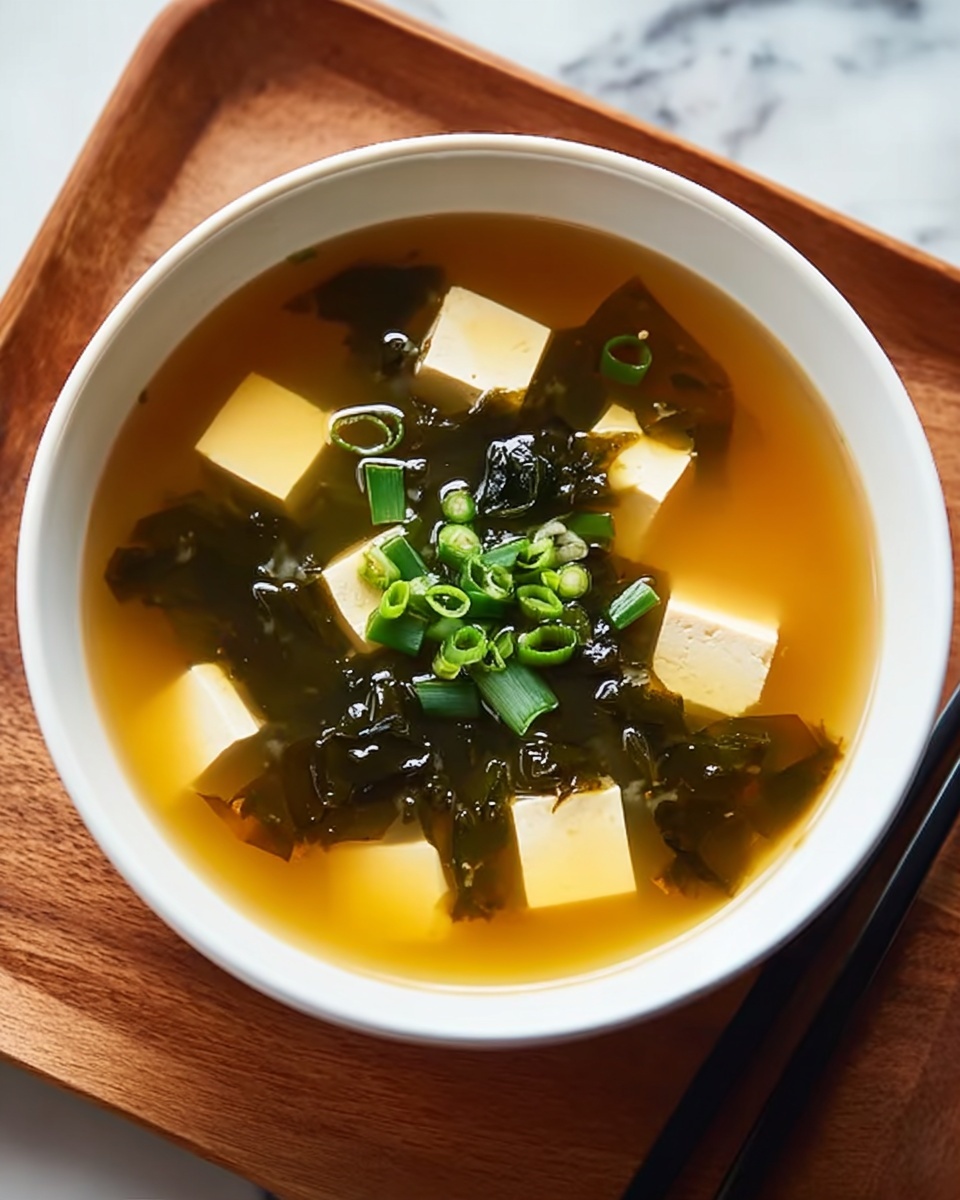If you have ever craved a warm, savory bowl of comfort that feels like a gentle hug in a cup, then this Homemade Miso Soup with Tofu Recipe is exactly what you need. This classic Japanese soup is incredibly simple yet bursting with layers of umami flavor, courtesy of kombu, bonito flakes, miso, and delicate silken tofu. It’s a perfect blend of soothing broth, tender tofu cubes, and vibrant seaweed that’s not only nourishing but also wonderfully quick to prepare. Whether you’re new to miso soup or looking to perfect your traditional method, this recipe will guide you through creating a beautifully balanced dish that feels both elegant and homey at the same time.

Ingredients You’ll Need
The magic of this Homemade Miso Soup with Tofu Recipe lies in the simplicity and freshness of its ingredients. Each one plays a crucial role in building the smooth texture, deep flavor, and vibrant appearance of the soup, making it a truly authentic experience right from your kitchen.
- Water: The base of your dashi broth, bringing everything together with purity and clarity.
- Kombu (dried kelp): Adds a subtle oceanic depth and richness—essential umami for the broth.
- Katsuobushi (dried bonito flakes): Brings smoky, fishy notes that elevate the soup to new flavor heights.
- Soft/silken tofu: Provides a silky, melt-in-your-mouth texture that contrasts beautifully with the broth.
- Miso paste: The heart of the soup, giving it that signature savory sweetness and complexity.
- Dried wakame seaweed: Adds a pop of color and a tender, slightly chewy texture.
- Green onion/scallion: Freshness and mild sharpness that brighten up the entire bowl.
How to Make Homemade Miso Soup with Tofu Recipe
Step 1: Prepare the Dashi Broth
Start by gently simmering 4 cups of water with a piece of kombu, about 4 x 4 inches, to extract its rich umami essence. Be sure to remove the kombu right before the water boils to prevent bitterness. Then add the dried bonito flakes, letting them steep for a few minutes off the heat before straining the liquid. This clear, flavorful broth is the foundation for your soup and sets the tone for all the layers of taste to come.
Step 2: Prepare the Soup Ingredients
While your dashi is taking shape, cut your soft silken tofu into gentle cubes—handle it with care since it’s delicate and prone to breaking. Thinly slice the green onion into rounds for that splash of fresh brightness. Rehydrate the dried wakame seaweed in water so it softens and blooms to its vibrant green color.
Step 3: Combine and Heat the Soup
Return the strained dashi broth to the pot and warm it slowly over low heat. Stir in the miso paste carefully, using a ladle to dissolve it smoothly without letting the soup boil, as boiling can destroy the rich flavors and beneficial enzymes in the miso. Add the tofu cubes and softened wakame, warming them through gently to keep their textures perfect.
Step 4: Final Touch with Green Onions
Right before serving, sprinkle the thinly sliced green onion into the pot. Their mild pungency and fresh crunch provide a lovely contrast and an inviting aroma that makes each spoonful even more delightful.
How to Serve Homemade Miso Soup with Tofu Recipe

Garnishes
A sprinkle of toasted sesame seeds or a tiny drizzle of chili oil can add subtle layers of flavor and texture to your homemade miso soup. Freshly cut shiso leaves or a pinch of finely shredded nori are also great for adding a touch of herbal brightness or ocean essence, making every serving feel special and personalized.
Side Dishes
This soup shines as a light starter or companion to a Japanese-inspired meal. Think fluffy steamed rice, a simple cucumber sunomono salad, or grilled teriyaki salmon. Even a plate of crispy tempura or vegetable gyoza dances beautifully alongside this comforting broth, balancing textures and flavors on your dining table.
Creative Ways to Present
Serve your miso soup in charming lacquer bowls to embrace its Japanese roots. For a contemporary twist, try clear glass mugs to highlight the tofu cubes and seaweed as they float serenely in the golden broth. You can also turn this traditional soup into a vibrant lunch by adding noodles or vegetables like mushrooms and spinach to make it heartier while maintaining the authentic profile.
Make Ahead and Storage
Storing Leftovers
Keep leftover miso soup in an airtight container in the refrigerator for up to 2 days. Because the tofu absorbs flavors over time, it may change texture slightly but will still be delicious when reheated gently.
Freezing
Freezing is not recommended for Homemade Miso Soup with Tofu Recipe because the tofu’s silky texture can become grainy and the miso flavor may dull after thawing. To best enjoy this soup, prepare only what you plan to eat within a couple of days.
Reheating
Reheat the soup on the stove over low heat, stirring gently to warm it evenly. Avoid boiling to preserve the miso’s delicate flavors and maintain the tofu’s soft texture. If the soup thickens too much in the fridge, add a little water or dashi broth to loosen it before reheating.
FAQs
Can I use instant miso soup packets instead of making dashi from scratch?
While instant miso packets are convenient and tasty, making your own dashi from kombu and bonito flakes gives you a richer, more authentic flavor that really elevates the Homemade Miso Soup with Tofu Recipe. It’s worth the little extra effort!
What type of miso should I use for this recipe?
For this soup, white (shiro) miso or a mild blended miso works best because of its subtle sweetness and lighter flavor, allowing the dashi and tofu to shine. However, feel free to experiment with red or mixed miso to match your taste preferences.
Is there a vegetarian version of this soup?
Absolutely! Simply omit the bonito flakes and rely on kombu for the umami-rich broth. You can also add shiitake mushroom broth to enhance the depth and maintain the hearty flavor without any animal products.
Can I add vegetables to this miso soup?
Definitely! Adding thinly sliced mushrooms, spinach, or daikon radish can make the soup more wholesome while keeping its traditional roots. Just add them during the simmering stage so they cook gently.
How do I prevent the tofu from breaking apart?
Using soft or silken tofu means it’s naturally fragile. Cut it carefully into larger cubes and add it towards the end of cooking with very gentle stirring. Use a slotted spoon or ladle to serve it delicately into bowls.
Final Thoughts
This Homemade Miso Soup with Tofu Recipe is like a warm invitation to savor simple, wholesome ingredients transformed into something truly comforting. Whether you’re winding down after a busy day or looking to impress friends with an authentic Japanese classic, this recipe is your new go-to. I can’t wait for you to taste the cozy, umami-kissed goodness that only homemade miso soup can offer—happy cooking!
Print
Homemade Miso Soup with Tofu Recipe
- Prep Time: 10 minutes
- Cook Time: 10 minutes
- Total Time: 20 minutes
- Yield: 4 servings
- Category: Soup
- Method: Stovetop
- Cuisine: Japanese
- Diet: Gluten Free
Description
A comforting and traditional Japanese Homemade Miso Soup recipe featuring a savory kombu and bonito dashi broth, silky soft tofu, wakame seaweed, and fresh green onions. Ready in just 20 minutes, this miso soup is a nourishing appetizer or light meal for 4 servings.
Ingredients
Dashi Ingredients
- 4 cups water
- 1 piece kombu (dried kelp), ⅓ oz (10 g), 4 x 4 inches (10 x 10 cm)
- 1 cup katsuobushi (dried bonito flakes), loosely packed 3 cups for stronger flavor (optional for non-vegetarian version)
Miso Soup Ingredients
- 7 oz (200 g) soft/silken tofu (kinugoshi dofu)
- 4 Tbsp miso paste (about 1 Tbsp or 18 g per cup/240 ml dashi)
- 1 Tbsp dried wakame seaweed
- 1 green onion/scallion, thinly sliced
Instructions
- Prepare Dashi: Pour 4 cups of water and add the kombu to a saucepan. Slowly heat the water to just before boiling, then remove the kombu to avoid bitterness. If using bonito flakes for a traditional dashi, add the flakes now, simmer for a few minutes, then strain the broth to remove solids.
- Prepare Ingredients: Thinly slice the green onion/scallion and cut the soft tofu into bite-sized cubes. Soak the dried wakame seaweed in water for a few minutes until rehydrated and then drain.
- Make the Soup: Return the dashi to the pot and bring it to a gentle simmer. Lower the heat, dissolve the miso paste into the broth by whisking or stirring gently, taking care not to boil the miso to preserve its flavor and probiotics. Add the tofu cubes, soaked wakame, and sliced green onions to the soup.
- Serve: Once heated through, serve the miso soup immediately in bowls while warm, ensuring a fresh and comforting flavor.
Notes
- Do not boil the soup after adding miso paste to preserve its delicate flavors and nutritional benefits.
- For a vegetarian or vegan version, omit the bonito flakes and add more kombu or dried shiitake mushrooms for umami.
- Soft tofu (silken) is traditional for this soup, but firm tofu can be used if preferred.
- Adjust the amount of miso to taste; some prefer a lighter or stronger miso flavor.
- Kombu can be reused once for a lighter dashi or composted after use.








